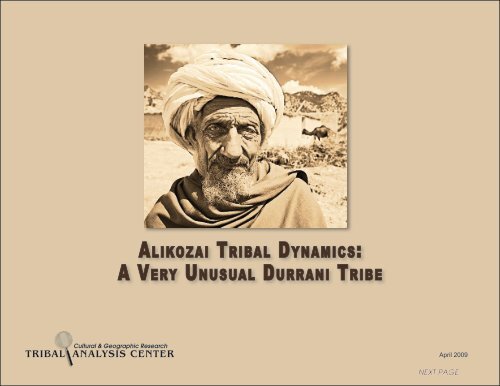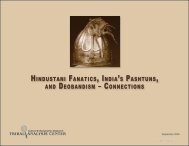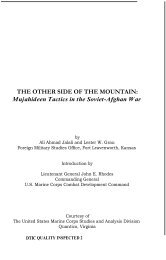ALIKOZAI TRIBAL DYNAMICS: A VERY UNUSUAL DURRANI TRIBE
ALIKOZAI TRIBAL DYNAMICS: A VERY UNUSUAL DURRANI TRIBE
ALIKOZAI TRIBAL DYNAMICS: A VERY UNUSUAL DURRANI TRIBE
Create successful ePaper yourself
Turn your PDF publications into a flip-book with our unique Google optimized e-Paper software.
A l i ko z a i Trib a l Dynamics:<br />
A Very Unusua l Durrani Tribe<br />
Cultural & Geographic Research<br />
<strong>TRIBAL</strong> ANALYSIS CENTER<br />
April 2009
Alikozai Tribal Dynamics: A Very Unusual Durrani Tribe<br />
A l i ko z a i Trib a l Dynamics:<br />
A Very Unusua l Durrani Tribe<br />
Copyright © 2009 Tribal Analysis Center, LTD<br />
All Rights Reserved<br />
Cultural & Geographic Research<br />
<strong>TRIBAL</strong> ANALYSIS CENTER<br />
About Tribal Analysis Center<br />
Tribal Analysis Center, 6610-M Mooretown Road, Box 159. Williamsburg, VA, 23188
Alikozai Tribal Dynamics: A Very Unusual Durrani Tribe<br />
Alikozai Tribal Dynamics: A Very Unusual Durrani Tribe<br />
The Alikozai Durranis are very unlike the other Durrani tribes located in southern Afghanistan. There is a large concentration of this tribe<br />
within the Arghandab Valley and their generally well-defined tribal boundaries may have been responsible for them developing a high degree of<br />
independence. They seem, however, to be estranged from many of their fellow Durranis and have demonstrated their independence by affiliating with<br />
non-Pashtuns during periods of both conflict and political competition. The reasons for their alienation are deeply rooted in the violent history of the<br />
Pashtun tribes. Some of these reasons have been recorded, but much of this history is not available and can only be estimated from the few factors<br />
available. Something – probably a series of “somethings” – set the Alikozai along a generally confrontational path with the other Durranis.<br />
Tribal balance of power was clearly a factor in the intra-tribal strife that was always occurring within these competing tribes. At one time, the<br />
Alikozai tribe was a highly respected part of the Abdali tribes, a large group that would later evolve into the Durrani Confederation. Their early<br />
primacy is illustrated by the fact that an Alikozai, Abd al-Ghani Khan, led the Abdali warriors that were forced to enter Persian Nadir Shah’s service<br />
following their defeat at Herat in 1732. 1 As a reward for their service, according to a Pashtun historian who wrote in 1874, “...the valley of the<br />
Arghandab falling [sic] to Ghani Khan and his clan the Alikozai for distinguished service by the Abdali tribe to Nadir Shah.” 2 This rich valley near<br />
Kandahar remains the primary location of the Alikozai tribe.<br />
Following Nadir Shah’s death in 1747, Ahmad Khan, a Popalzai, was given the leadership of the Abdalis, which he renamed Durranis, and as he<br />
consolidated his power he worked to weaken the other tribes that might later challenge his primacy. For example, the largest of the Abdali/Durrani<br />
tribes, the Barakzai, was weakened when Ahmad Khan, now Ahmad Shah Durrani, ordered the tribe’s Achakzai subtribe to be split from the Barakzai<br />
as a separate tribe within the Abdali/Durrani Confederacy. 3 It is very likely that the Alikozai received similar weakening efforts during the reign of<br />
Ahmad Shah Durrani.<br />
Ahmad Shah’s efforts were in vain, however, and the Barakzai were able to replace the Popalzai monarchs that followed him, but succession crises<br />
that followed allowed unrest to develop among the tribes. In early 1800, the Ghilzai tribes rose in rebellion and soon there were large-scale riots<br />
in Kabul between Sunni and Shia. Equal unrest developed within the Durrani tribes, but most of this is difficult to document – especially the court<br />
intrigue in Kabul in which individual Alikozai tribesmen were involved. One of them was involved in the blinding and subsequent execution of one<br />
of the Barakzai leaders in the region, Fateh Khan. 4<br />
In the two decades of unrest that followed, Afghanistan was divided into three independent chieftainships ruled from Kabul, Herat, and Kandahar.<br />
This was the situation when the British placed Shah Shuja on the throne at Kabul in 1839. By 1842, Shah Shuja had been murdered, and in Herat,<br />
Kamran, the region’s ruler, was murdered by his Wazir, Yar Mohammad Khan, an Alikozai, who assumed control of Herat. 5<br />
1. Noelle, Christine, State and Tribe in Nineteenth Century Afghanistan, pg. 230.<br />
2. Hyat Khan, Muhammad, Afghanistan and its Inhabitants, translated by Henry Priestly, 1981, reprint of 1874 edition, pg.63.<br />
3. Noelle, pg. 230.<br />
4. Ibid, pg. 6.<br />
5. Le Messurier, Augustus, Kandahar in 1879; Lumsden, Harry, The Mission to Kandahar, pgs. 2, 3, 4.<br />
Tribal Analysis Center, 6610-M Mooretown Road, Box 159. Williamsburg, VA, 23188
Alikozai Tribal Dynamics: A Very Unusual Durrani Tribe<br />
In Kabul, an Alikozai named Nawab Foujdar became the British agent at the Amir’s court in 1857. He was described as a being loyal to the British<br />
government. 6<br />
In 1856, the Alikozai ruler of Herat was ousted by one of the Sadozai leaders. The Sadozai are a leading subtribe of the Popalzai, another principal<br />
Durrani tribe. The violent politics continued in the region and as late as 1880, the Alikozai were allied with the Aimaqs and the Ishaqzai in a futile<br />
attempt to place Yar Mohammad Khan’s grandson on Herat’s throne. 7<br />
More recently, the Alikozai leader, Mullah Naqib allied himself and most of the Alikozai mujahedin that fought the Soviets and Afghan communists<br />
with Jamiat-i Islami, even though this political party was dominated by Tajiks led by Burhanuddin Rabbani. Larry Goodson wrote that the Jamiat<br />
was less rigid ideologically and its commanders enjoyed much greater autonomy than was seen in the other mujahedin groups. Goodson mentioned<br />
that several of Jamiat’s regional commanders, including Ahmad Shah Masood of the Panjshir Valley and Ismail Khan of Herat, rose to national<br />
prominence. Mullah Naqib was able to become very prominent locally as the principle Pashtun member of the Jamiat-i Islami. 8<br />
For some unrecorded reason, probably an event that occurred between the Durrani defeat at Herat by Nadir Shah and his Persians in 1732 and the<br />
formation of the Durrani Confederation in 1747, the Alikozai lost their primacy among these tribes. While Abd al-Ghani Khan led these tribes to the<br />
Persian victory at Daghestan and had their lost lands returned, their fortunes seem to have waned considerably since that time.<br />
Weakened, and probably alienated, the Alikozai seem to look toward forces outside the Pashtun tribes for support against their Durrani, if not all<br />
Pashtun, antagonists. They were allied with Nadir Shah’s Persians, the British were supported by Nawab Foujden, an Alikozai, the Alikozai joined<br />
forces with the Aimaqs in an attempt to regain control of Herat, and they allied themselves with the non-Pashtuns of Rabbani’s Jamiat-i Islami against<br />
the Soviets and the Afghan communists. More recently, a substantial number of Alikozai tribesmen publicly supported Tajik Yunus Qanuni against<br />
fellow Durrani Hamid Karzai in the 2004 Presidential elections. 9<br />
While precise reasons for the Alikozai’s independence remain unfathomable, there are discernable differences between them and many of the other<br />
tribes in the region. For example, the Alikozai’s largest population concentration is in Kandahar’s Arghandab district, an area northeast of Kandahar<br />
City. Having the advantage of well-defined tribal boundaries in Arghandab district – and to a lesser degree in Helmand Province’s Sangin district, the<br />
Alikozai remained sufficiently strong to retain their independence of action. In this regard, they may be viewed as the probable “Keeper of the Tribal<br />
Balance of Power” in southeastern Afghanistan. They also benefited from the consistent presence of a strong, charismatic leader, Mullah Naqib,<br />
who consistently demonstrated a pragmatic nature that kept the best interests of the Alikozai foremost during his political maneuvering. His recent<br />
unfortunate death left a significant power vacuum within the Alikozai tribe as three factions tend to compete of its leadership: Khan Mohammad’s<br />
group, those allied with the Wasify family, and Mullah Naqib’s supporters backing his young son, Qarimullah Naqibi.<br />
6. Bellew, Henry, Journal of a Political Mission to Afghanistan in 1857, pgs. 90, 96.<br />
7. Lee, Jonathan, The Ancient Supremacy, pg. 400.<br />
8. Goodson, Roy, Afghanistan’s Endless War, pp. 62-63.<br />
9. Researcher made these direct observations in 2004.<br />
Tribal Analysis Center, 6610-M Mooretown Road, Box 159. Williamsburg, VA, 23188
Alikozai Tribal Dynamics: A Very Unusual Durrani Tribe<br />
Apparently, the Taliban leadership took notice of the key political and strategic positions held by the Alikozai. There are few positions within the<br />
Taliban held by an Alikozai and only one, Mullah Obaidullah, was in a senior leadership position. He was captured by Pakistan’s security services in<br />
February 2007 and the Alikozai are no longer represented in the Taliban leadership.<br />
Events also seem to indicate that the Taliban have actively targeted Alikozai leaders:<br />
• Haji Granai, a deputy to Khan Mohammad in both the Afghan Militia Force and Kandahar’s police department, was assassinated by unknown<br />
assailants.<br />
• Akram Khakrezwal, Kabul’s police chief, was assassinated by a suicide bomber during Mullah Abdullah Fayez’s funeral ceremony in a<br />
Kandahar mosque in May 2005.<br />
• Mullah Naqib was nearly killed in a mine explosion that killed one of his sons and severely injured another.<br />
• Abdul Hakim Jan was killed in a large bombing at a dog fight in February 2008.<br />
• Sangin district’s Dad Mohammad Khan was killed in a large mine explosion on the highway between Kandahar and Lashkargah. Apparently<br />
singled out, Dad Mohammad Khan’s extended family and his closest aides have also been attacked. Three of his brothers were killed<br />
along with approximately 50 others in an attack at Sangin bazaar two years ago.<br />
From the Taliban’s likely perspective, the Alikozai may be too independent to be trusted. Some of their victims were violent men who were widely<br />
despised, but no more so than many of the other local power brokers in southern Afghanistan. But the Alikozai tribe is receiving special attention<br />
from the Taliban, and the arrest of Mullah Obaidullah left the Alikozai with few, if any, Alikozai leadership personalities in the Taliban at any level.<br />
The apparent attack campaign may be related to Mullah Naqib’s – and his Alikozai faction surrounding his son – support for Hamid Karzai, but<br />
the violence could be equally related to the Alikozai’s traditional alliance with non-Pashtun power centers, this time with Rabbani, Qanuni, and their<br />
Tajik-dominated Jamiat-i Islami. The attacks may be intended to intimidate the Alikozai while producing a general power vacuum into which Talibanleaning<br />
individuals may eventually move. Finally, the Taliban may be maneuvering to separate the Alikozai from the remainder of the Zirak Durrani<br />
tribes – the Barakzai, Popalzai, and Achakzai subtribes. They may believe that the Panjpai faction of the Durranis are sufficiently estranged from the<br />
mainstream Zirak, and they are now concentrating their efforts to force an open split within the Zirak Durranis by focusing their efforts against the<br />
Alikozai.<br />
The Alikozai tribe occupies a unique position in the power struggle in southern Afghanistan and their removal from their general connection to<br />
Hamid Karzai and/or to the Jamiat’s Tajiks would strengthen the Taliban’s position during renewed conflict or in the case of reconciliation negotiations<br />
and a political settlement of the Afghan insurgency. Either or both are very possible. 10<br />
10. The researcher worked closely with the tribes mentioned in this study during extended trips into southern Afghanistan in 2003, 2004, and 2005.<br />
Tribal Analysis Center, 6610-M Mooretown Road, Box 159. Williamsburg, VA, 23188
Alikozai Tribal Dynamics: A Very Unusual Durrani Tribe<br />
Alikozai Tribal Hierarchy<br />
Ethnic Group<br />
Confederation<br />
Tribe<br />
Clan<br />
Division<br />
Pashtun Durrani Zirak / Zarak Alikozai Bashozai<br />
Dadozai<br />
This table is a hierarchical representation of each documented<br />
lineage group--from largest ancestral division to smallest<br />
subordinate element--of the Alikozai. This information has been<br />
compiled from a variety of historical and contemporary sources<br />
and should regarded as a work-in-progress. It will be updated as<br />
new and more complete sources of information become available.<br />
Please contact the Tribal Analysis Center , if you are able to<br />
provide additional information on either the pedigree or other<br />
cultural characteristics of this tribe.<br />
Daolatzai<br />
Jaluzai / Jaluzae<br />
Karazai<br />
Khalozai<br />
Khanizai<br />
Kutezai<br />
Melazai / Melazae<br />
Nasozai<br />
Nausazai<br />
Sandarzai<br />
Surkani / Sarkani<br />
Tribal Analysis Center, 6610-M Mooretown Road, Box 159. Williamsburg, VA, 23188
Tribal Analysis Center<br />
Traditional anthropological research conducted among tribes inhabiting remote<br />
areas where insurgents and criminals operate has become increasingly difficult<br />
to implement. Studies carried out among people living in small-scale societies<br />
now are nearly impossible due to the physical dangers associated with the<br />
civil and religious unrest found in those areas. Swat, for example, has become<br />
so dangerous that Frederick Barth’s studies only could be repeated at the<br />
risk of the investigator’s life. Similar research is not feasible among Burma’s<br />
Rohinga tribes located on both sides of the border with Bangladesh, as well as<br />
with the Pashtuns in Afghanistan’s interior and within Pakistan’s Federally<br />
Administered Tribal Areas, where even Pakistan’s army enters with reluctance.<br />
Given the difficulties of conducting direct fieldwork in conflictive areas, the<br />
Tribal Analysis Center utilizes an indirect approach. Using multidisciplinary<br />
research, we seek to collect and analyze data obtained from a wide variety of<br />
sources, both current and historical. In the absence of new ethnographic<br />
fieldwork to update our base of knowledge, the Tribal Analysis Center compiles<br />
and summarizes existing research and documents on tribal societies, combining<br />
this material with contemporary press reports and articles. We assume that much<br />
can be gleaned from well-informed observers who are not anthropologists, ranging<br />
from journalists and travelers to government officials.<br />
Please visit us at:<br />
www.tribalanalysiscenter.com
















